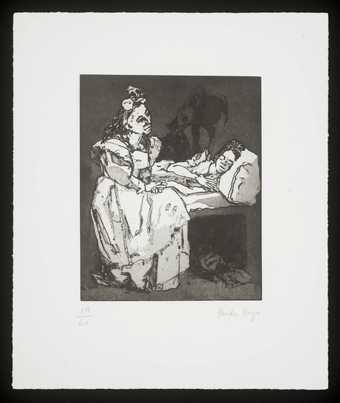
Paula Rego installation view 1996 Tate Liverpool
Paula Rego is an artist whose reputation rightly continues to grow. A prominent figure within the contemporary British art world, she was born in Portugal in 1935. She trained at the Slade School of Art in London and settled permanently in London in 1976. She had her first major solo exhibition in Britain at the Serpentine Gallery in London in 1988 and has since featured in several important contemporary survey exhibitions. She has represented both Britain and Portugal in the Sao Paulo Bienal.
This retrospective exhibition presents Paula Rego's work from 1959 to the present. The artist is best known for her large, figurative paintings from the late 1980s and 1990s, which are here placed in the context of early paintings and collages. Drawing has always been a vital part of Rego's working practice, and this exhibition includes a substantial selection of studies and sketches, preparatory and finished drawings from the artist's own collection, seen here for the first time.
Rego works in series, in sequences and in stories. Her paintings recount and reshape a recognisable, if ambiguous narrative. She uses stories as shared commodities, sites of communication between artist and viewer, private and public, individual and collective. Rego's paintings are like stories with the narrative taken out: the viewer is presented with characters and a situation, and may improvise a story for themselves. The artist uses strong imagery, its initial identity or its actual form often borrowed from a source we might recognise – fairy tales, films and fables, the work of other artists or from a shared popular culture – to engage the viewer's imagination, to implicate us in the fate of the pictorial characters she creates.
Drawing is important to Rego – it is the medium in which her ideas start. Her usual practice when beginning to make a painting is to make a series of imaginative drawings, testing out her ideas and playing with possibilities. From these, she may begin to tryout ideas with a model, making life drawings which, when the pose is right, may be squared up and transferred to the final canvas. However, the composition is rarely fixed until the painting is completely finished – new images, motif and stories keep occurring to the artist throughout the painting process. Rego's is a dynamic practice; a combination of desire, suggestion, idea and narrative. When she works directly from her imagination, she tries to catch her conscious mind out, working as intuitively as possible, subjecting herself and her images to the demands of the story as it unfolds. When she works from a model, the model may dictate the pose – moving and changing until Rego recognises the moment the picture requires her to capture.

